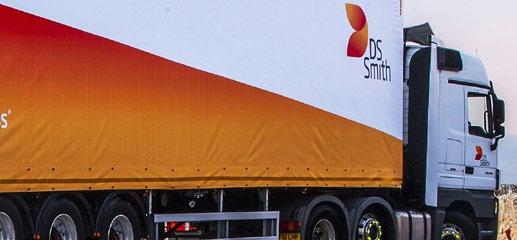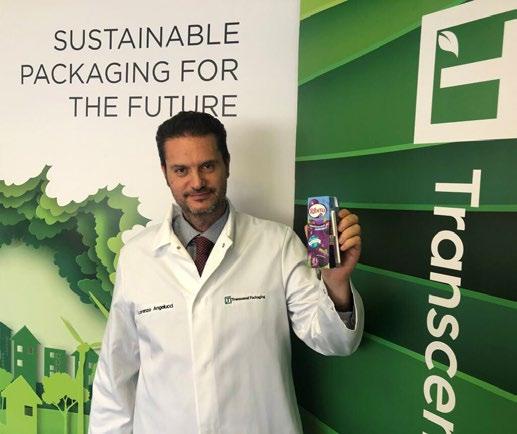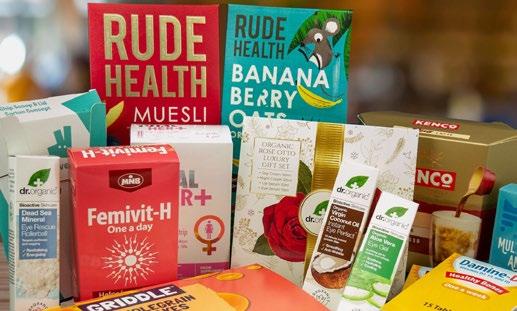
7 minute read
An Endemic Cardboard Pandemic?
from SPN Jan 2022
by spnews.com
Supply-chain Sleuths An Endemic Cardboard Pandemic?
In the UK alone, there are more than 135m cardboard boxes stowed in homes as almost half of Brits admit to hoarding them. New data shows that 44% of Brits admit to hoarding cardboard boxes – with a massive 135m believed to be sitting in our sheds, garages, and wardrobes.
Advertisement
Over half of Brits (52%) say the amount of cardboard packaging in their homes has increased since the pandemic, with two thirds (66%) of those blaming more online shopping, and more than a quarter (28%) holding on to boxes without any clear motive - simply because “they might be useful in the future.” But the hoarding habit, while seemingly harmless, is actually keeping raw materials out of the hands of recycling companies and causing paper prices to rise. Since the pandemic begun there’s been a major shift in consumer shopping habits and we’ve seen a huge rise in people ordering more items online, accumulating more boxes as a result. But while some put these boxes to good use – reusing them for storage, arts and crafts, or to ship other items - many boxes are sitting unused and not finding their way back into recycling streams. It means that materials are at best getting delayed in reaching recyclers, and at worse not getting to them at all. So Rogier Gerritsen, Head of Recycling at DS Smith told SPN, “We rely on a circular business and have a unique 14-day box to box model, meaning we take the boxes we make, then collect, recycle and convert them into new boxes all within 14 days. As well as being Europe’s largest cardboard and paper recycler, we’re committed to leading the transition to the circular economy. We globally manufacture billions of boxes from recycled fibre every year and find solutions for customers that replace problem plastics, and remove carbon from supply chains. Further data shows that one in five Brits (20%) are holding on to between 5 and 10 boxes, with 10% hoarding 10 to 19, and 4% with at least 20 boxes stowed away at home. Those who admit to hoarding say that the most popular places to store them are in the garage (34%), a wardrobe or cupboard (30%), or in the shed (23%). Of those who have seen an increase in cardboard packaging within their homes, 15% say they are keeping boxes for arts and crafts projects, while around a quarter (24%) use them for storage, and the same amount (24%) use them for shipping other items. Disturbingly, 22% say there isn’t enough room in their recycling bin or bag to dispose of the boxes, with around one in ten (9%) confessing they don’t know how to recycle them, and the same number (9%) not knowing where to recycle them. Furthermore, a total of 11% of Brits admit to throwing cardboard packaging in the general waste bin with 8% even saying that they burn it. Gerritsen added, “Unfortunately these results once again show the need for a better, clearer infrastructure to help ensure what should get recycled does get recycled. We recently showed that 49% of British households admit to completely running out of space in their recycling bins, with a quarter saying this happens every two weeks or more 1. Changes and reforms that make it clearer and easier for people to recycle at home would ensure far more of these valuable materials get used again and again, reducing our impact on the environment. Simon Weston, Director of Raw Materials at the Confederation of Paper Industries said, “ We know cardboard boxes can be useful around the home and encourage people to re-use them where possible, but where they aren’t re-used and instead hoarded, they represent untapped resources that could be recycled to make new products. Britain currently has millions of these boxes laying idle in cupboards, sheds and garages, and we would ask anyone who is stowing them away to instead recycle them responsibly, so the raw materials can be put back into practical use.
20-20 Vision Transcendental advantage
In an increasingly remote, digital world, packaging has become the new frontline in the battle to develop and optimise customer relations. Transend Packaging offers some insights…
Matt Ward, Print and Digital Division Director of Transcend Packaging told SPN about the advantages of tactical packaging in relation to optimising a company’s customer relations.“In today’s digital-first world, brands should be maximising the commercial value of their packaging by creating a meaningful way to interact with customers, without a physical presence. ‘Tactical Packaging’ offers businesses - from the FTSE 100 to recent start-ups it provides newfound opportunities to provide a special experience and develop customer relations to a new level. “Whether through seasonal or promotional offers, tactical packaging’s value is derived from physically being in a consumer’s hand. This could be in the form of buying a chocolate bar with a meaningful message on the packaging, or QR codes appearing on your soft drink bottle – that’s because they are increasingly being used to supplement packaging and drive client engagement. “The value of developing customer relationships, as more people work from home, is garnering increasing influence in the battle for market share. This is especially prevalent in sectors like healthcare and grocery, where saturated markets and homogenous products compete for the same limited and localised market. Indeed, global intelligent packaging sales are forecasted to reach $2.5 billion by 2025 with an annual average growth rate of 13.3% from 2020. The question for brands, especially those subliminally familiar to consumers browsing the aisles of their local supermarket, is how can you encourage and maintain brand loyalty whilst altering the design spec that makes your brand recognisable?
Tactical techniques
Since the Covid Pandemic, QR codes have become a part of everyday life – from reading menus to paying. Research shows that 96% of the UK population have scanned a QR code on their mobile device in restaurants or shops in the last six months from April 2021. Despite their huge success, QR codes are just one of many tactical packaging techniques. Willingness to be inclusive of other mediums, such as the randomised data that is available through the use of imagery and text, is enabling tactical packaging to revolutionise how businesses approach their consumer relations.



New-found opportunities
This presents a real opportunity for brands to take their packaging to the ‘next level’, meaning that packaging has the potential to deliver personalised experiences to each consumer. Brands should see this as a valuable opportunity to introduce customers to their website or app ecosystems. In turn, helping businesses improve their understanding of a products’ customer base, which without a physical presence, can be more challenging to obtain. When it comes to packaging, businesses have a newfound opportunity to tailor and adapt the product rapidly. However, this is only part of the impressive element. What’s equally exciting is that changes can be made in line with consumer sentiment and feedback, or for seasonal events like the festive period, at a fraction of the price quoted with traditional packaging processes, such as litho-printing. The packaging industry has long utilised a ‘price per thousand’ mentality, where volume and cost is prioritised above all else. For many years, not enough attention was paid to a product’s performance during or at the end of its useful life. Now with the latest innovations in digital printing, it is now possible to produce multiple, bespoke packaging designs, in smaller batches and in a fraction of the time it takes for litho-printing.
Digital derivatives reducing waste
On a digital press, a brand can handle a print-run of thousands of cartons, with each carton using a different tailored-design. Standards are changing, and the technology is now there for brands and creatives to do what was never previously practical. This reaches beyond just design and acts as an important servant to reducing waste. The countless digital printing derivatives are changing the conversation for the packaging industry and its partners, and we expect successful brands will be those who welcome the era of smart packaging. So therefore, order only what you need, pay for only what you need and keep waste to an absolute minimum and whilst doing so, build powerful consumer relations, which can in turn be reinforced at any given time throughout the year.” Matt Ward’s new perspectives and his conclusions all add weight to the growing movement for greater interaction and creativity with customers. Any company that prioritises its customers in this way, stands to benefit significantly in years to come.





